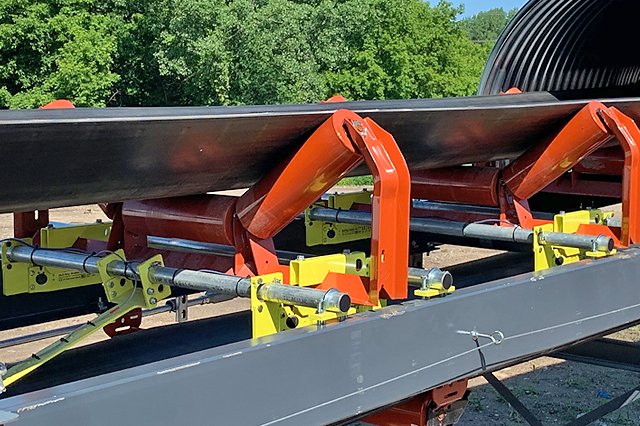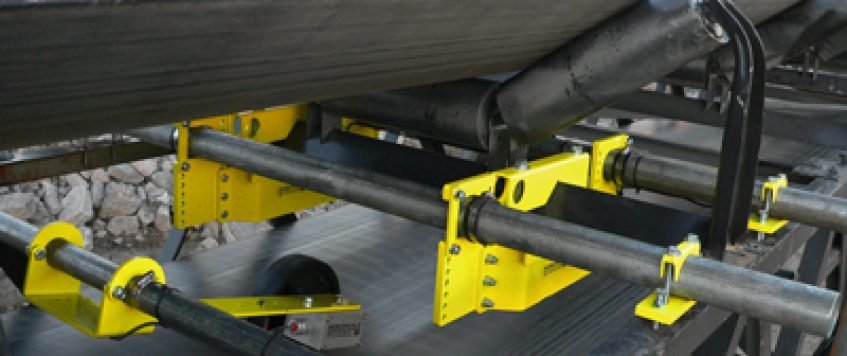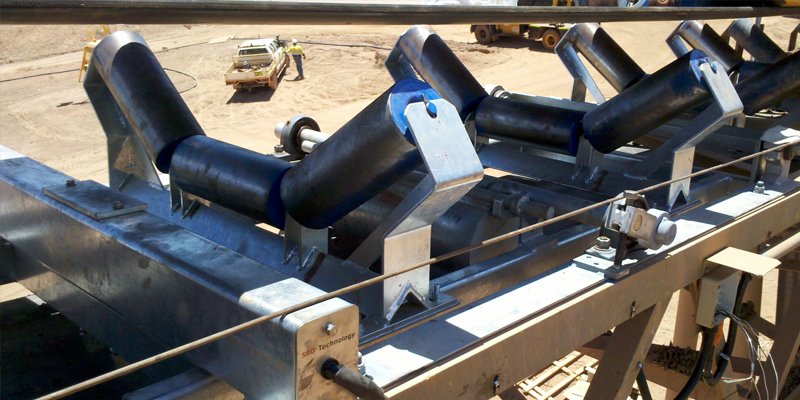Understanding Belt Scales
Belt scales are a unique method of retrieving accurate weight measurements in a more logistically challenging environment. They are not like a truck scale with a steel deck, nor is it like a bench scale with stainless steel components. Belt scales are scales on conveyor belts to ensure accurate and consistent material flow rates. Conveyor belts are supported by weigh frames that consist of load cells, rollers or idlers resting on the load cells, and speed sensors typically installed in tail pulleys on the conveyor belt. As material is carried on the conveyor, the load is measured by the load cells while speed and distance are collected by the speed sensors. This data is processed and displayed as pounds or kilograms per hour and total weight, on a weight indicator. Operators can control the flow of material to keep the supply to production lines consistent. Weigh frames are connected to weight integrators or process controllers that can communicate to peripheral equipment such as computers and printers.
CALIBRATING BELT SCALES
Calibrating your scale is essential to ensuring that you have an accurate measuring scale. Many scale manufacturers will have a Belt scale calibration that is a lot different from a conventional scale. A regular calibration schedule is good to keep your scale running optimally. If the material weighed on your belt scale is sold based on weight, you should contact a certified scale technician to perform regular inspections and calibrations as required by your local agency. A zero calibration should be performed daily; this is done by running the conveyor belt while it is empty to check the load cells and indicator register no weight on the scale. The load cells will be different from typical analog and electronic load cells.
MATERIAL COMPARISON CALIBRATION
To calibrate a Legal for Trade belt scale, you must perform a material comparison calibration. For this method, you need access to a certified scale such as a truck scale or a railroad scale. Material that passes over the belt scale must be weighed on the certified scale either before or after it’s weighed on the belt scale.
Use enough material for the belt scale to run for a minimum of 10 minutes or match the load obtained at maximum flow rate in one revolution of the belt to meet local agency requirements. After the material weight has been compared on both scales, a span adjustment can be performed on the belt scale to match the certified vehicle scale.
STATIC CALIBRATION
A static test weight calibration is most likely the simplest calibration method to perform. Belt scales require specialty calibration weights due to the unique design of a belt scale. Some systems allow weights to be semi-permanently attached to the weigh frame so the weight can be applied to the load cells as needed. For belt scale systems that don’t have this option, using a hanging weight set to check the load cells without the conveyor running is an alternative option.
A failed conveyor belt scale can bring the whole bulk handling operation grinding to a halt. So surely it is necessary to opt for reliability above all else.
The quarrying contract commits to removing a certain quantity of rock or gravel every single day. These numbers must be achieved – and have to be verifiable. If the company is engaged to load cargo for rail or sea transport, container after container has to be filled without the risk of overloading them. When working on a major demolition project specific targets for recycling building materials such as concrete and masonry must be met. In all these scenarios, uninterrupted operation is vital. When being forced to halt the conveyor belts unexpectedly because of a breakdown, valuable production time or the passage of goods will be lost.
Service levels will fall below what is expected. There could even be the risk of a hefty fine for breach of contract or for safety failings. A small but sophisticated piece of machinery, a belt scale is fitted to a conveyor belt to continuously measure the quantity of material being carried. The scale determines the amount of material by simultaneously weighing the belt load and measuring the belt speed. But if it develops a fault, this means that the conveyor belt comes to a standstill.
MAINTAINING YOUR BELT SCALE (WITH TIPS)
As mentioned before in the article, creating a regular service schedule for your scale will help keep your belt scale. To prevent common problems from shortening the lifespan of your scale, then setting up a maintenance schedule will help keep your scale running properly. The scale should be checked frequently to determine when calibration is required. It is recommended that zero calibration be checked every other day and that calibration be checked every week for several months after installation. Observe the results and lengthen the period between calibration checks, depending upon the accuracy desired.
Here are some tips to help keep your belt scale operating properly:
Cleaning: Keep the scale area clean of rocks, dust and material build-up. Also clean surrounding scale accessories (scoreboard, remote display, junction box, scale indicators)
Lubrication: The weigh idlers should be greased one to two times yearly. Overloading the weigh idlers with grease can change the tare weight and place the scale out of calibration. A zero calibration is necessary after greasing.
Idler Alignment: The alignment of the scale service idlers to close tolerance is the single most important step in the installation of a belt weighing system. In order to minimize the dynamic effects of the moving belt and to provide a straight belt path through the scale, the weigh area idlers must be aligned to close tolerance.
Belt Tension: It is important that the conveyor conditions remain constant at all times. Therefore, gravity-type take-ups are recommended on all conveyors where belt scales are installed. Conveyors which do not have a constant tension device will require calibration whenever the belt tension changes and the take-up is readjusted.
Residue on Belt: Material can form a film on the belt which is carried continually around the belt and is never discharged. This condition is often true when handling wet, fine material. Belt scrapers may correct this condition. If the film can’t be removed, the zero will have to be adjusted. Any change in the build-up of the film adhering to the belt will require further adjustment.
CLOSING WORDS
Belt scales are a great way to keep production flow up and still get consistent accurate weight measurements. They are a good way to ensure that your operation does not have a slow down period as well as get heavy materials weighed and distributed. Be sure to visit our belt scale products page to see which scales are offered. At American Scale we are dedicated to providing unparalleled customer service and information. We have articles about truck scale installation, weighing applications, as well as truck scale foundations and warranties. Also be sure to check out our article about belt scale accuracy, to check out methods on ensuring scale accuracy as well as other articles like How much do truck scales cost.



